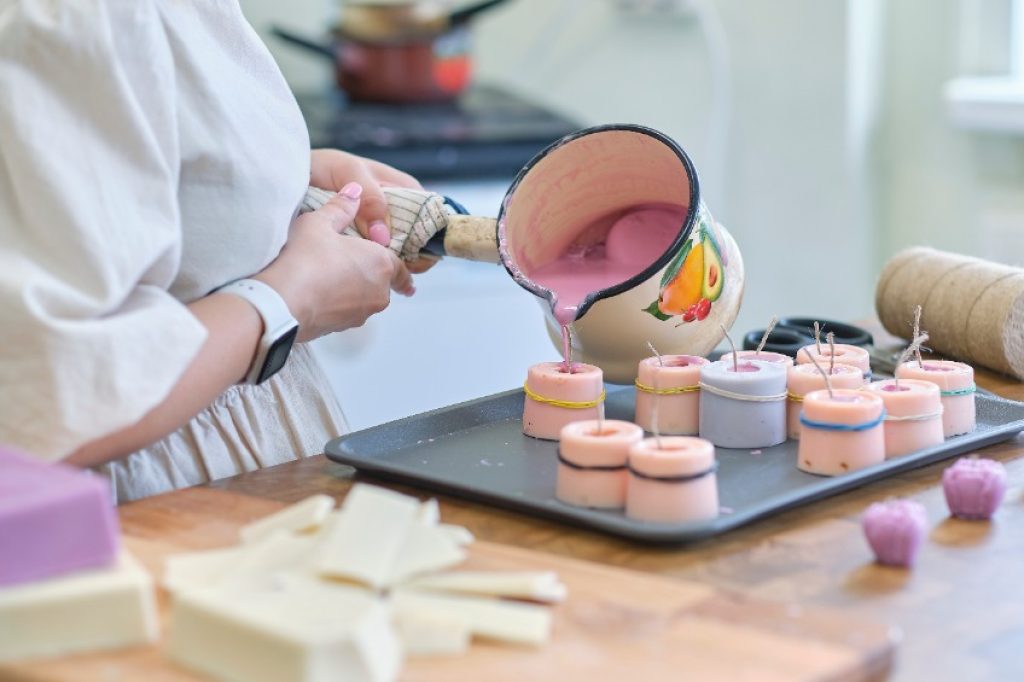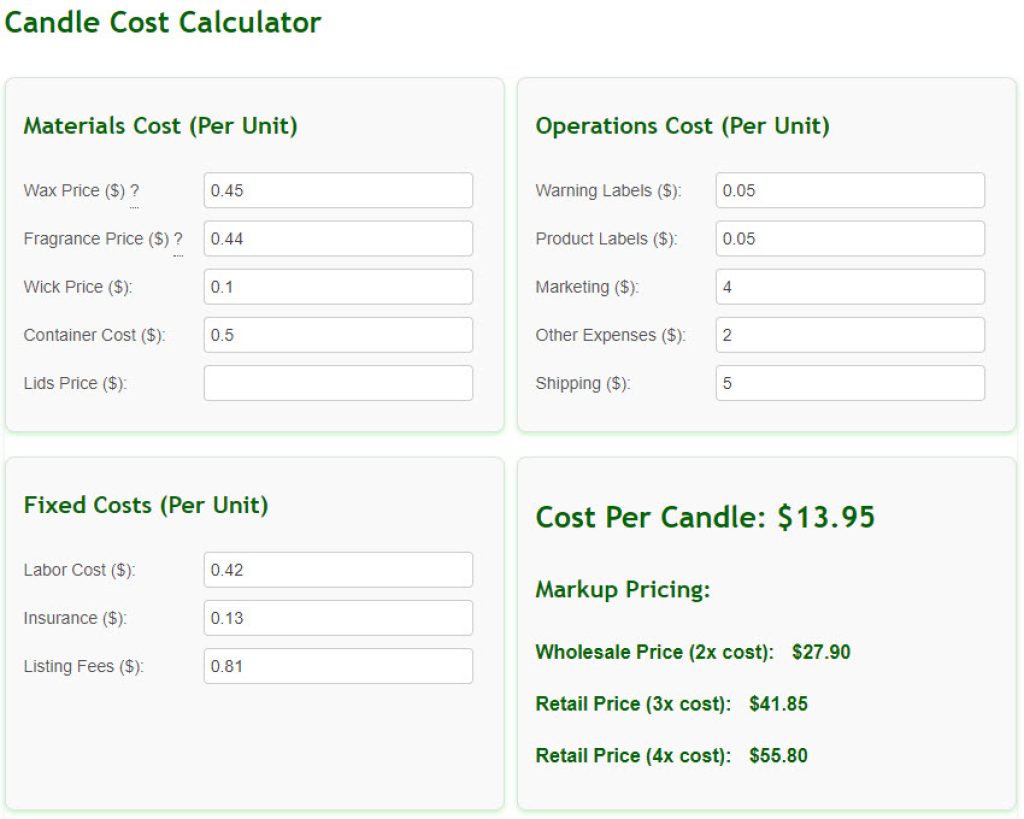Candle Cost Calculator, The Price of Making Candles
We have created a candle cost calculator to help you make smart pricing decisions for your handmade candles. We also thought of sharing tips on excelling in the homemade candles business.
Candle Cost Calculator
Materials Cost (Per Unit)
Operations Cost (Per Unit)
Fixed Costs (Per Unit)
$0.00
First, know why people buy your handmade candles. People look for the uniqueness of a product to purchase something special or unique. The quality of the product adds to the uniqueness factor since it speaks about the time, effort, and money invested in making those exclusive items.
Here’s more.

The Perks and Advantages of Starting A Homemade Candles Business
Homemade candle businesses have come a long way from what they used to be. It’s easier than ever today to make homemade candles, and it’s also easier to find ways to sell them.
With a proactive structure and data-driven business plan in place, you can reap the advantages of having your handmade candle business, like:
- Having complete control over pricing and marketing.
- Getting to keep all the profits from the sales of your handmade candles.
- Having no inventory costs since you make the candles with incoming orders.
- Customizing your products based on customer specifications.
Everything is online, at your disposal, from the capital goods you need for candle making to the raw materials, the how-to guides in multimedia format, and the marketing potential of websites and social media, you can use the free business hashtag generator Increase exposure in social networks.
The Profit Margins in the Candles Making Business
A business identifies a gap in the market and offers a solution to customers’ problems for a price. Its ability to make profits depends on numerous factors, such as efficient management and pricing strategies.
For small businesses, especially those that deal with handmade goods like candles, it is important to maintain positive cash flow and be profitable to remain competitive in the market. Having an appropriate pricing strategy is crucial for success.
The profit margins in the candle-making business vary depending on various factors, including the type of candles you make (regular or specialty), materials used, and pricing.
However, the single-most-important factor is marketing while targeting the right customers. If you optimize your marketing and reach the right people, then the price will be less of an issue as they’re likely to pay more for quality products.
The profit margins will be pretty decent, considering homemade implies no corporate rent. Other methods of pushing profit margins upward include:
1. Creative, Suitable Branding
Branding entails more than designing logos and color schemes. It includes researching customer preferences and identifying the right kind of target customers. For example, if you make specialty candles like aromatherapy, your branding should reflect the organic nature of the product.
2. Streamlining Your Process
Time is money, and improving the production process means making more candles in less time. Automating particular processes would save you time as well as money. It also allows you to create products faster and meet customer deadlines.
3. Smart Pricing Strategy
Some businesses sell bulk at minimal pricing, relying on quantities of scale to profit. Others offer exclusive products for a higher price and focus on quality instead of quantity. The best way is to combine both by offering bulk items at a low price and exclusive products at higher prices.
But don’t just take it from me. Take advantage of this candle price calculator to help you make smarter pricing decisions and increase the profitability of your handmade candle business.
4. Diversify Your Products
Adding a few more products to complement your main product line can increase profitability. You could offer aromatherapy candles, for example. You could also add other scented and unscented candle varieties to your portfolio.
How To Use the Candle Price Calculator
Like a typical balance sheet, this candle price calculator bundles your expenses and stacks them against your desired profits.
Factoring the Expenses
The main benefit of using this candle price calculator is that it reminds you of the most significant costs to consider for this business.
The expenses you need to factor in are:
- The cost of the raw materials (Per Unit) used for your candles (e.g., wax, wick, scent) and labor costs (including the time it takes to make candles and other overhead costs like electric bills)
Here are some of the things you might need to make candles at home:- Wax is the main ingredient in candles. It can be made from paraffin wax, beeswax, soy wax, or palm wax, among other things.
- Wicks: These are the strings that run through the middle of the candle and help it burn.
- Fragrance oils or essential oils: These are added to the wax to give the candle a smell.
- Dyes: are added to the wax to change the color of the candle.
- Heat-resistant container: This is where the wax goes to cool and harden.
- Double boiler or melting pot: This is used to melt the wax without burning it.
- Thermometer: This is used to make sure the wax is at the right temperature before pouring it into the container.
- Stirring tool: This can be a spoon or a piece of wood that is used to mix the fragrance oils or dyes into the wax as it melts.
- Tape or glue dots: keep the wick in the middle of the container while the wax cools. With these, you can cut the wick down to size before lighting the candle.
- Labels: These tell you what the candle smells like and what color it is.
Keep in mind that the materials you need will depend on the kind of candle you want to make and the method you choose.
This calculator bundles the cost of production, including materials and labor, into the total cost of production.
- Operations Cost (Per Unit): Input expenses for warning labels, product labels, marketing, other expenses, and shipping costs.
- Fixed Costs (Per Unit): Fill in the costs for labor, insurance, and listing fees.
- Review the Results:
- After you input all the costs, the calculator will automatically update the ‘Cost Per Candle’ at the bottom.
- Additionally, it will provide suggested wholesale and retail prices based on the cost per candle.
Saving Your Results as a PDF
To save the details of your calculation:
- Complete your calculations on the calculator.
- Use your web browser’s print function (usually found in the menu or by pressing
Ctrl + Pon Windows,Cmd + Pon Mac). - In the print dialog, change the destination to ‘Save as PDF’.
- Choose your desired save location and save the PDF for future reference.
Note
This tool is designed to provide a quick estimate. It’s always a good idea to review your calculations or consult with a financial advisor for detailed business planning.

Deciding How Many Candles to Make
Finding the sweet spot in profitability isn’t complicated, but you must factor in taxes and target gross profit margins. Calculating the number of candles you need to make within a given time is where this calculator shines.
You control all the variables in the equation with your projections or desired figures for every metric, and it tells you how many candles you would have to sell for you to hit your target number.
Of course, all these calculations do not guarantee success in the handmade candle market, but they are a great starting point and can help you make smarter decisions.
Different Types of Candles:
If you are selling different types of candles, you can use the template below as an example:
| Candle Name | Candle Type | Ingredients | Cost | Price | Quantity Sold | Profit | Date Made | Date Sold |
|---|---|---|---|---|---|---|---|---|
| Lavender Vanilla | Jar Candle | Soy wax, lavender essential oil, vanilla fragrance oil, wick | $5 | $12 | 10 | $70 | 3/1/2023 | 3/15/2023 |
| Cinnamon Spice | Pillar Candle | Beeswax, cinnamon essential oil, nutmeg essential oil, wick | $8 | $20 | 5 | $60 | 3/5/2023 | 3/20/2023 |
| Eucalyptus Mint | Tealight Candle | Soy wax, eucalyptus essential oil, peppermint essential oil, wick | $3 | $8 | 20 | $100 | 3/10/2023 | 3/25/2023 |
What Risks Face Homemade Candles-Making Businesses?
From omission to commission, homemade candle business owners face all sorts of risks, although having a homemade candle-making business can be profitable. These businesses face general business risks and extra perils unique to their industry.
Some general business risks involved in running a homemade candle-making business include the usual delivery or production accidents, legal risks from customer complaints, and money management risks.
For example, lackluster pricing strategies or bad debt collection practices can lead to financial losses.
Home-based businesses also expose their owners to other potential risks, such as injuries sustained while working with hot wax. Moreover, property damage or harm to third parties due to misusing homemade candles could cause legal risks.
Mitigating the Risks in the Homemade Candles Business
You can mitigate risks in the homemade candles business by sticking to the following best practices:
1. Deploying Safety Protocols
Handmade candle-making business owners are mandated to prioritize safety for employees, consumers, and third parties. You should follow appropriate regulations, such as the ones set by your local and state governments.
Using unsafe materials or tactics to reduce costs can cause harm and potential legal action.
2. Using A Candle Cost Calculator
We can’t overemphasize the importance of using a pricing calculator when setting prices for each candle. Keeping an eye on the cost of production and ensuring that you have enough profit margin to sustain business operations should be your top priority.
The same applies to marketing costs. Setting realistic projections and leveraging existing resources wisely is essential for success.
3. Getting Relevant Small Business Insurance Covers
Finally, having a reliable business insurance policy is paramount for any small business. Homemade candle businesses should get specific coverages to cover fire, theft, and general liabilities, among other risks associated with their operations.
The right type of insurance can save your business from financial ruin. All suitable business insurance policies can ensure your homemade candles business is well protected from lawsuits and help to recover losses from unexpected events.
Tips to Cut Costs
Saving money while making candles can significantly impact your profit margins and overall business success. Here are some practical tips to help you cut costs without compromising the quality of your candles:
Bulk Purchasing
- Buy Supplies in Bulk: Often, suppliers offer discounts for larger purchases. Buying wax, wicks, fragrances, and containers in bulk can reduce the per-unit cost significantly.
Supplier Relationships
- Negotiate with Suppliers: Build good relationships with your suppliers and negotiate for better prices. Loyalty can sometimes earn you discounts or better terms.
Efficient Production
- Streamline Production: Optimize your candle-making process to reduce waste and increase efficiency. This might include better measurement techniques to minimize excess materials or optimizing production steps to save time and energy.
Cost-Effective Alternatives
- Explore Alternative Suppliers: Don’t hesitate to shop around and compare prices from different suppliers. Sometimes, you can find more cost-effective options without sacrificing quality.
DIY Approaches
- Make Your Own Blends: Consider creating your own fragrance blends using essential oils or fragrance oils, which can be more cost-effective than pre-made scents.
Recycling and Reusing
- Reuse and Recycle: If possible, recycle leftover wax and consider reusing containers. Also, you can offer discounts to customers who return containers for refills.
Energy Efficiency
- Save on Utilities: Use energy-efficient methods for melting wax, like using a well-insulated melter. Implementing energy-saving practices in your workspace can reduce utility bills.
Packaging and Shipping
- Economical Packaging: Find cost-effective packaging solutions that protect your candles without being overly expensive. For shipping, compare rates between carriers and consider flat-rate shipping if it’s cheaper.
Effective Marketing
- Word-of-Mouth and Social Media Marketing: Utilize free or low-cost marketing channels like social media, word-of-mouth, and local community events. Effective marketing doesn’t always have to be expensive.
Waste Reduction
- Minimize Waste: Be conscientious about reducing waste in your production process. This includes being precise in measuring ingredients to avoid excess and reusing materials whenever possible.
Incremental Scaling
- Scale Gradually: As your business grows, scale your operations incrementally to avoid unnecessary expenses. Gradual scaling helps you manage costs more effectively.
Monitor and Adjust
- Regularly Review Costs: Keep a close eye on all your expenses. Regular reviews can help you identify areas where you can cut costs or improve efficiency.
Remember, while reducing costs is important, maintaining the quality of your candles is crucial for customer satisfaction and business sustainability. Balancing cost-saving measures with quality output is key to long-term success in the candle-making business.
The Lowdown
In conclusion, the importance of using a pricing calculator for your handmade candles cannot be understated.
We also can’t overemphasize the need to mitigate most other risks associated with running a small business.
Doing so will help you make smarter decisions and keep your business profitable. Furthermore, the right business insurance coverages can help you keep your business safe from any unwelcome surprises.
FAQ:
How to Price Homemade Candles?
Pricing homemade candles can be challenging, as you want to make sure you are charging enough to cover your costs and make a profit, but not so much that customers are unwilling to pay.
Here are some steps to consider when pricing your homemade candles:
- Calculate the cost of materials: The first step is to determine the cost of the materials used to make the candles, including wax, wicks, fragrances, containers, and labels. This will give you a baseline cost for each candle.
- Consider your labor costs: Next, you should factor in the time it takes to make each candle. Calculate how much you want to pay yourself per hour and multiply that by the number of hours it takes to make each candle.
- Determine overhead costs: Overhead costs are the expenses you incur that are not directly related to making the candles, such as rent, utilities, marketing, and packaging. Divide your monthly overhead costs by the number of candles you produce each month to determine the overhead cost per candle.
- Set your profit margin: Determine the profit margin you want to make on each candle, usually around 20-30% of the total cost.
- Research the market: Look at the prices of similar candles in your local market and online. This will help you determine a fair price for your candles based on the current demand and competition.
- Price your candles: Add up the cost of materials, labor, overhead costs, and desired profit margin to determine the total cost per candle. Finally, set your selling price based on your research and what you believe your target customers are willing to pay.
It’s important to remember that pricing your candles too low may not always be beneficial, as it may devalue the time and effort you put into making them. It’s also important to keep in mind that pricing too high can make it challenging to sell your candles, especially if there are similar products available at a lower price.
Set your business goals with our goals writing tool.

